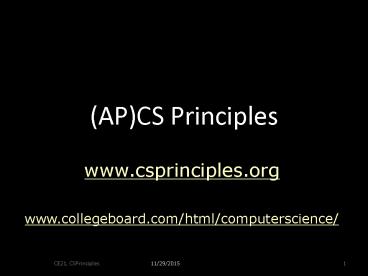(AP)CS Principles - PowerPoint PPT Presentation
Title:
(AP)CS Principles
Description:
(AP)CS Principles www.csprinciples.org www.collegeboard.com/html/computerscience/ CE21, CSPrinciples * * What? A new first course in computer science Alternative to ... – PowerPoint PPT presentation
Number of Views:102
Avg rating:3.0/5.0
Title: (AP)CS Principles
1
(AP)CS Principles
- www.csprinciples.org
- www.collegeboard.com/html/computerscience/
2
What?
- A new first course in computer science
Collaborative CollegeBoard, NSF, Academia
(6-12/University)
Designed to be an AP course credit/placement
Alternative to CS1, not replacement
3
Why toward APCSprinciples?
- Why isnt this CSPrinciples, why AP?
- Entry into high schools and colleges
- 2,000 audited AP(CS) teachers
- National standard for curriculum/test
- Single point of national leverage
- States are very, very, very different
4
Who?
5
Process and Content
- How are we designing and building this course?
- Who is behind the development
- What is the process used
- What will be in this course?
- Computational Thinking Skills
- Content
- Pedagogy
6
Who?
- Dan Garcia
- Joanna Goode
- Susanne Hambrusch
- Michelle Hutton
- Deepak Kumar
- Jim Kurose
- Andrea Lawrence
- Richard Pattis
- Katie Siek
- Beth Simon
- Larry Snyder
- Lynn Stein
- Fran Trees
- Lien Diaz
- Cameron Wilson
- Jan Cuny
- Kathy Haynie
- Don Allen
- Christine Alvarado
- Owen Astrachan
- Stacey Armstrong
- Tiffany Barnes
- Amy Briggs
- Charmaine Bentley
- Mark Guzdial
- Rich Kick
- Jody Paul
- Chris Stephenson
- Duane Bailey
- Gail Chapman
- Tom Cortina
- Stephen Edwards
7
Timeline
- 2009-2010
- Big Ideas, Practices, Claims/Evidence
- 2010-11
- Pilot I Five colleges
- College Survey
- College attestation/support
- Test item prototype
- 2011-12
- Pilot II 10 colleges, 10 high schools
8
Timeline continued
- Necessary and sufficient conditions to continue
- How do we ensure substantial buy-in?
- 2012-2013, e.g., as part of CE21!
- Curricular framework finalized?
- Exam format identified
- Deploy exam and course
- 201X (X gt 5)
9
From Process to Product
- What will be in this course?
- Pilot courses are exemplars
- Seven big ideas
- Six computational thinking practices
- 30 claims each with 2-5 evidence statements,
total of 117 - From bits to NP to modeling to
10
Wheres the Programming?
- To that end solving computational problems and
exploring creative endeavors, the course
highlights programming as one of the seven big
ideas of computer science, because programming is
among the creative processes that help transform
ideas into reality. - Course rational, csprinciples.org
11
Big Ideas
- Computing is a creative human activity that
engenders innovation and promotes exploration. - Abstraction reduces information and detail to
focus on concepts relevant to understanding and
solving problems.
12
Big Ideas Continued
- Data and information facilitate the creation of
knowledge. - Algorithms are tools for developing and
expressing solutions to computational problems.
13
Big Ideas Continued
- Programming is a creative process that produces
computational artifacts. - Digital devices, systems, and the networks that
interconnect them enable and foster computational
approaches to solving problems.
14
Big Ideas
- Computing enables innovation in other fields
including science, social science, humanities,
arts, medicine, engineering, and business.
15
Computational Thinking Practices
- Analyzing effects of computation
- Creating computational artifacts
- Using abstractions and models
- Analyzing problems and artifacts
- Communicating processes and results
- Work effectively in teams
- csprinciples.org
16
Claims and Evidence bit.ly/csprinc
- Big Idea Abstraction reduces information and
detail to focus on concepts relevant to
understanding and solving problems. - Key Concept II.A. Computational systems and
problems are developed, analyzed, and solved
using multiple levels of abstraction.
17
Big IdeagtKey ConceptgtClaim
- Claim 5 The student can use abstractions and
models to solve computational problems and
analyze systems. - Evidence for Claim 5 Student work is
characterized by
18
Evidence statements for 5
- 5a. Explanation of how data, information or
knowledge are represented at different levels of
abstraction. - 5b. Use of simulation and randomness to analyze
and solve problems. - 5c. Explanation of how abstractions are used in
software systems at many levels, ranging from
programming languages to operating systems to the
Internet. - 5d. Explanation of the abstractions comprising
the physical layers of computing hardware,
including gates, chips, and components.
19
Future work
- Oversee pilot courses, analyze the outcomes of
the pilots, prepare for next, larger pilot,
LARGER PILOT - Gain consensus on claims and evidence
- Develop prototype exam questions
- Gather support for next phase of project, letters
of attestation
20
Questions
- http//www.csprinciples.org/pilots































